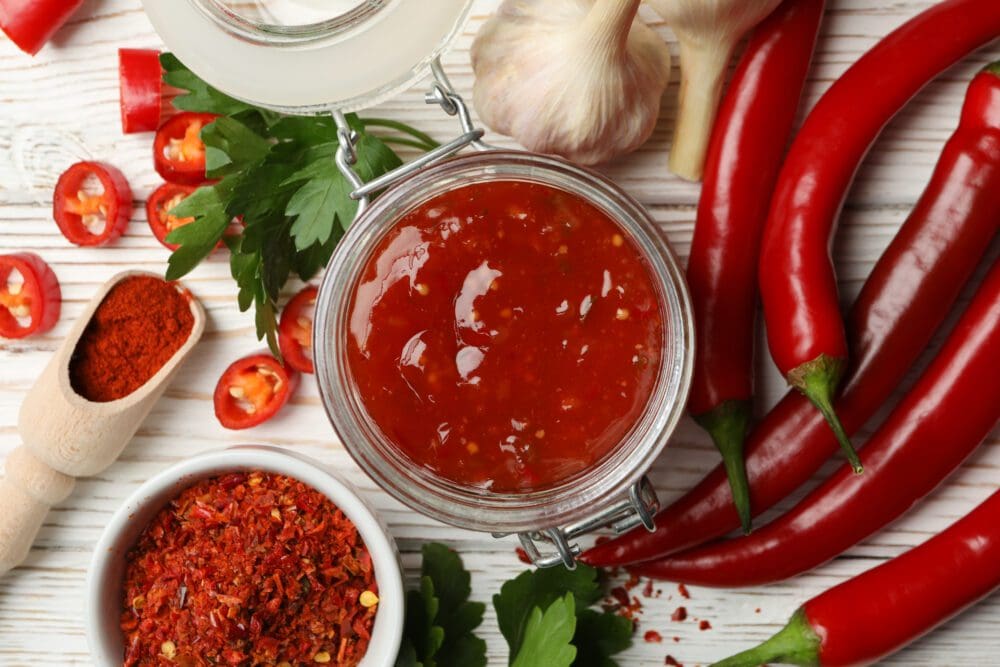
How to Make Fermented Serrano Pepper Hot Sauce at Home
Making your own hot sauce at home can lead you down a path towards creating the best hot sauce that you have ever tried in your life. To start, you can make quick non-fermented versions of hot sauce that combine hot peppers and vegetables cooked down in vinegar and water. If you want to take things a step further, consider lacto-fermenting your peppers and vegetables in a 2-2.5% salt solution, and then add some vinegar and sugar after you have let the vegetables ferment for a few weeks.
Ingredients
Ingredients for Fermentation:
- ¼ fresh pineapple (150g, rind removed, roughly chopped)
- 20 serrano peppers (200g, stems removed, cut in quarters)
- 2 Jalapeno peppers (30g, stems removed, cut in quarters)
- 2 small white onions (175g, roughly chopped)
- 2 small carrots (70g, peeled and roughly chopped)
- 6 cloves garlic (20g, peeled)
- 600 g water
- 32 g Kosher salt
Post-Fermentation Ingredients:
- 100 g ½ cup white granulated sugar, optional
- 10 oz apple cider vinegar
- 10 oz water
Instructions
- Try to buy organic produce, where the exterior of the fruit is less likely to contain pesticides.
- Clean and sanitize your mason jar.
- Add the chopped pineapple to the Mason jar.
- Add the hot peppers on top of the pineapple.
- Add the chopped white onions, carrot, and garlic cloves.
- Stir together 600g of room-temperature water with 32g of Kosher salt.
- When the salt has completely dissolved, wait until the water returns to a clear color, or about 2 minutes.
- Press down on the vegetables with a spoon, and pour the salt water brine on top until the vegetables and pineapple are completely covered.
- Add a glass or ceramic weight to keep everything submerged below the surface of the salt water brine.
- Secure the contents with a lid, and open up the contents every day, as gas will escape from the vegetables and need to be released from the jar periodically during the fermentation process.
- Note at this stage that your ideal fermentation environment should be dark with a steady temperature of roughly 65˚-70˚F.
- Every day, open the jar to release the built-up CO2, and to check on the progress of your fermentation.
- Ensure that the vegetables are submerged in the brine daily, and wait for roughly two or three weeks.
- After you have waited for the roughly three weeks and you are ready to finish the fermented hot sauce, transfer the fermented contents to a blender container.
- Blend on high speed until the contents arrive at a puree consistency.
- In a small sauce pot on the stove, combine remaining apple cider vinegar, water, and white granulated sugar in a pot on the stove.
- Increase the heat to medium, and stir until the sugar is dissolved.
- Allow the liquid to cool, and then mix with the blended fermented peppers and vegetables from earlier.
- Pass the contents through a fine-mesh strainer.
- Taste your strained hot sauce, and add additional Kosher salt or white granulated sugar, if desired.
- Transfer the final strained sauce into individual bottles using a funnel.
- Store in the refrigerator until you are ready to use.
Notes
If you want to increase the heat level, swap out roughly 100 grams of the serrano peppers with fresh habaneros.